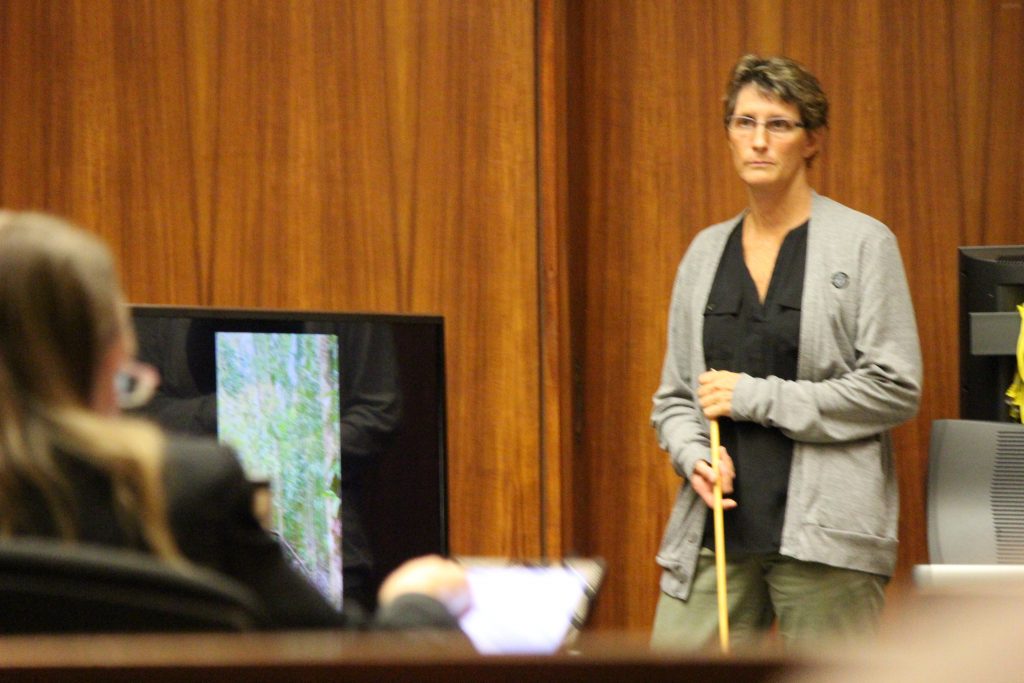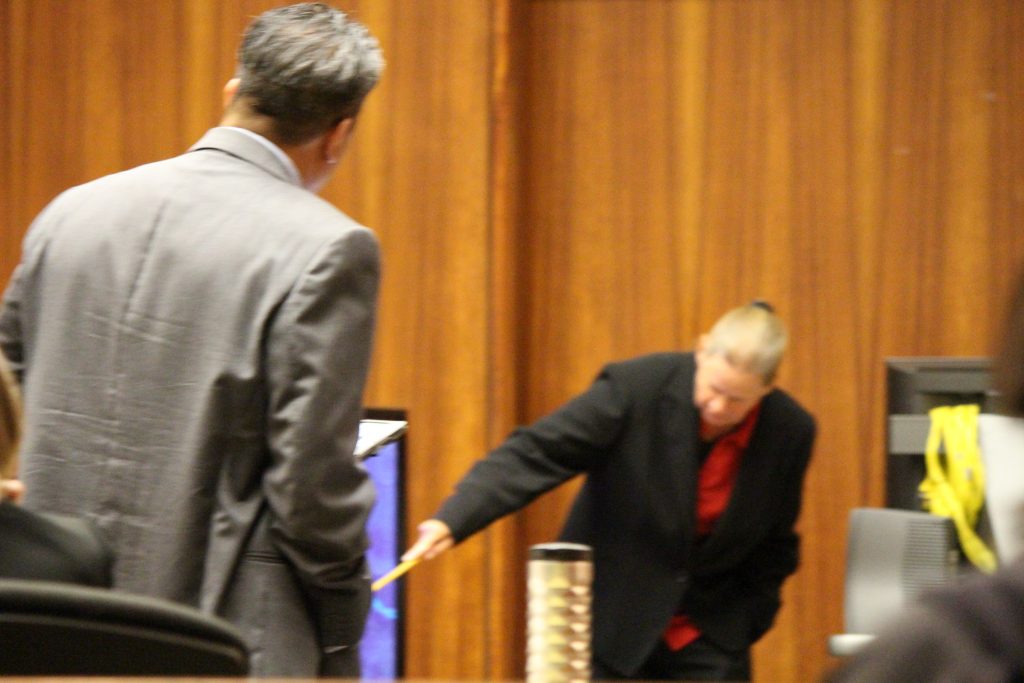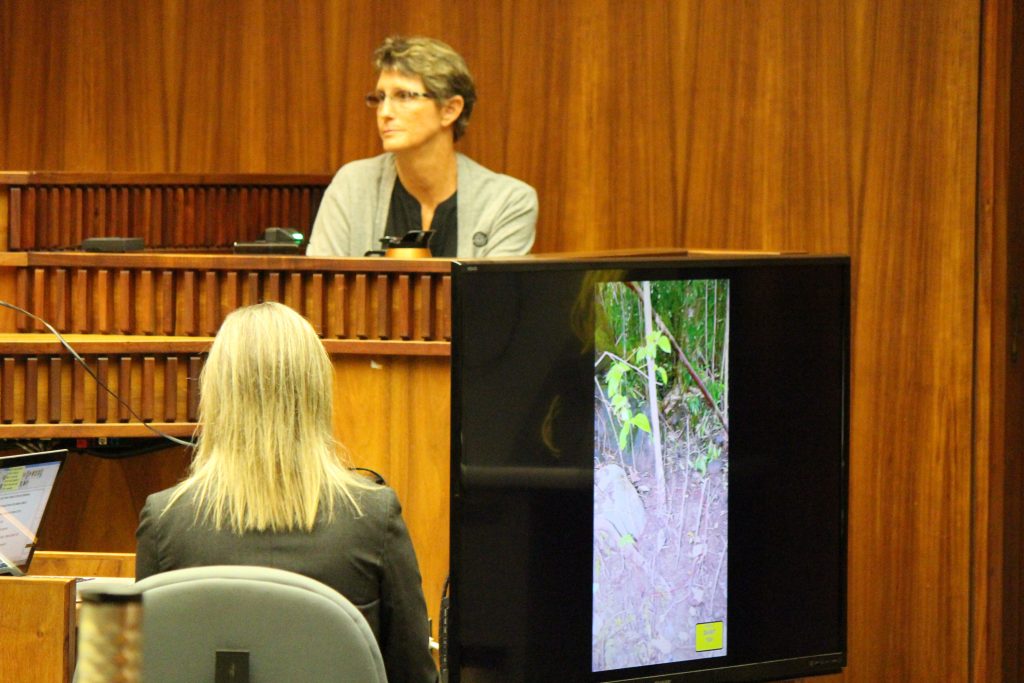Capobianco Trail: Cadaver Dogs Alert Searchers to Wooded Area

Teresa Gejate. Photo by Wendy Osher 8.29.16
Two dog handlers with a Human Remains Detection Unit testified in the ongoing murder trial of Steven Capobianco on Monday.
Both described how their cadaver dogs demonstrated changes in their body carriage, pace and energy level during searches conducted on Maui, signs their handlers say, indicate that they had keyed in on the odor of human remains.
The site was located in a heavily wooded area off of the Hāna Highway between a dirt cutout and a stream. The alert location that the dogs led searchers to, was in a more open area where trees had been cut down between a thin tree and a large rock, witnesses testified.

Honolulu Police Det. Sharon Walden, unit leader of the Hawaiʻi Urban Search and Rescue Team. Photo 8.29.16 by Wendy Osher.
One of the dogs also showed changes in body carriage and unusual “snorkeling” behavior at the stream, according to testimony.
The cadaver dogs were used in two searches, the first of which was conducted on Feb. 20, 2014, 11 days after Charli Scott had gone missing. The other search was conducted using the same handlers and dogs on March 8, 2014.
Scott was the pregnant ex-girlfriend of the defendant. She was last reported to have given Capobianco a ride to an area about three miles past Keʻanae on Feb. 9, 2014, where the defendant told authorities his vehicle had stalled.
Capobianco has pleaded not guilty to the charges. He is also accused of setting Scott’s vehicle on fire.
The trial continues today with testimony from Fire Investigator James Blando, a 24 year veteran of the Maui Fire Department, and 13 year fire investigator.

Honolulu Police Det. Sharon Walden, unit leader of the Hawaiʻi Urban Search and Rescue Team. Photo 8.29.16 by Wendy Osher.
Cadaver Dogs Alert Owners to Location Near Large Rock:
During testimony on Monday, dog handlers Sharon Walden and Teresa Gajate testified about the searches. Both are members of a voluntary unit that currently consists of 10-11 members. With no unit personnel currently stationed on the island of Maui, both were called in to assist the Maui Police Department’s Special Response Team.
Walden, the unit leader with the Human Remains Detection Unit for the state’s Hawaiʻi Urban Search and Rescue team, participated in the search with her dog Pōhaku. Walden is also a police officer with the Honolulu Police Department where she serves in the Professional Standards Office.

Teresa Gejate. Photo by Wendy Osher 8.29.16
Gajate, who is stationed on the Big Island of Hawaiʻi, was called to participate with her dog, Beckham, a Belgian Malinois breed. She has been a trainer for 17 years and Beckham is her third dog to be trained. He arrived from the mainland at a year and ½ in May of 2012 after already undergoing basic training on the mainland. He was 4 ½ years old at the time of the search.
While she flies to Maui on occasion to assist with studies on the incidental take of bird species on the grounds of the Kaheawa Wind Farm facility above Māʻalaea, Gajate said she is unfamiliar with the Hāna area where the searches were conducted.
Both women used GPS technology to record their movement during the searches, and referenced GPS technology data that was downloaded as an overlay on Google Earth maps, when pinpointing the exact locations they had stopped and areas of interest.
Walden testified that on Feb. 20, 2014, Maui police drove the searchers to various spots on the way to Hāna that were identified as areas of interest. Fellow searcher, Gejate said the team stopped at five spots that day.
One spot was around Mile 19.5 along the Hāna Highway where police said there were skid marks by a guardrail. Walden said she observed a depression in the dirt at the location, but her dog, Pōhaku gave no indication that there were human remains in the area.
The group next backtracked and stopped at an area along the Hāna Highway where there was a small dirt cutout. Detectives had designated a “large amount of acreage” including a heavily wooded area that they wanted to have searched. The team stayed in the area for two hours between noon and 2 p.m.
Walden and her dog Pōhaku decided to searched one half of the area, beginning at the upper roadway and working makai. Gajate and her dog Beckham searched the other half, starting from the bay and working their way up the road.
Walden described her dog as “laid back, for a working dog.” She said his behavior during the search of the location at first as “very slow, methodical” and “not very animated,” which she said was normal behavior when no odor of human remains are present.
Walden and her dog continued into a heavily wooded area and reached an area that was not as heavily vegetated where multiple trees had been cut down. In the area, Walden said Pōhaku began to show “lots of animation,” and a change in body carriage.
When he’s in the range of a final target odor, “his tail will helicopter and rotate versus wag,” said Walden.
“He was working very hard to locate where the odor was coming from,” said Walden who said Beckham was trained to get as close as he can to the final odor. Walden said the dog’s “trained and final response” is to sit if there are human remains present. According to Walden, Pōhaku sat down between a thin tree that was maybe 4-5 inches across and a large rock, that she described as maybe two feet across.
Walden said that because she was able to confirm that human remains had been recovered there, she rewarded Pōhaku with kibble and the two continued their search.
During earlier testimony, police said hair clumps, bone fragments and clothing allegedly belonging to the victim were recovered from Nuaʻailua Bay in East Maui. A blanket covered in maggots was also recovered from a stream at the site.
Walden and Gejate noted that police did not tell them in advance where evidence was found because they did not want it to influence the search effort. “We want to run the dogs blind so we don’t influence the dog in any way,” Walden testified.
Walden and her dog proceeded with a “serpentine” movement down to the stream bed, where Walden said Pōhaku showed a change in body carriage again and began exhibiting “unusual behavior” for him.
Although he doesn’t like water, Walden said Pōhaku put his feet in the stream and started blowing bubbles under the water with his nose, but did not go into final alert at that particular location. Walden said that upon return to the cars after the search, she was told by police that “clothing or something of that nature” was recovered from the stream bed area.
Gajate’s dog Beckham also alerted her during a search of the site. “There was one area he had strong interest in. It was very wooded. There was a stream going on one side of it,” said Gajate, who described the area as pretty thick with vegetation, except for the one area Beckham had interest in.
“When I sent him in to this area, his nose went down to the ground, and he sniffed really slow, very methodical. This was an open area next to a small tree and a rock,” said Gajate and described Beckham’s sniffing as “very intense.” Prosecuting attorney Robert Rivera asked if she noticed anything about the small tree, and Gajate responded saying, “It had cuts in it.”
Gajate said the dog did not giver her a final alert, but was methodically sniffing the area. “He was just sniffing a lot, around the tree and deep and around the ground,” she said, noting that her dog did not show an interest in any of the other four areas that were searched.
Gejate said Beckham is considered more of a faster dog, but he slows down when he alerts her to the odor of human remains. “When he first gets the smell, there’s a change of body carriage, he move towards the source, quickens his pace to search, then slows down when he finds the source, and will sit and bark to alert to the source.” If he were to detect an odor or show interest, he would slow down, according to Gejate.
The group took a break until about 3 p.m. when they got flagged by a young man rappelling from the edge of a cliff. The search team checked the edge of the roadway and took both dogs out, but Walden said Pōhaku did not have a change in carriage and there was no indication of human remains there.
At another stop, police drove Walden to a location where detectives said they recovered bloody clothing. Again, it was along the guardrail along the roadway. Walden said there were no indications of human remains in that area based on Pōhaku’s conduct.
A final search was conducted near a plant or city facility where police had indicated that they were unsure if it had been covered well. Walden testified that her dog showed no body carriage changes and there were no indication of human remains at the site.
Walden noted that the GPS technology can have a 15-17 meter variance for error when satellite reception is weak. Given the margin of error, defense attorney Jon Apo had few questions for either witness on cross exam.
According to testimony, the actual GPS unit, which consists of long antennas and a battery back, is not placed on the dogs because it restricts their movement and could interfere with the search mission. Gejate noted that the GPS was not set up properly during the Feb. 20, 2014 search, when asked about the exact track depicted in a map that was entered into evidence.
Cadaver Dogs Flown to Maui For Second Search
On March 7, 2014 Maui police made another request for assistance and the same unit members and dogs flew to Maui the following day on March 8, 2014, to search three locations.
In addition to the primary search area where canines had alerted their owners during the February visit, the unit also searched a private parcel.
“I believe they gathered info on a cell phone where it last pinged. It was on private land,” said Walden. Police gained access to the area via a locked gate and Walden and Gajate took different paths to search with their dogs, covering an area that was described as “a pretty harsh lava field.”
The search lasted about an hour, and no alert behavior was observed at the location.
“After that we went back to area we had initially been to on Feb. 20 that we designated as the primary search area. I think it was back towards town. Again, we wanted to hit the other side of the driveway that we parked in because we only hit the town side in February,” said Walden.
She said the team also wanted to check the previous location to try to see if the odor was still there or if it had dissipated.
After searing the Hāna or east side of the dirt road, Walden said, “We crossed over and got back into the initial area where dog had given the final alert previously,” said Walden.
Walden described the vegetation on the Hāna side or right side of the dirt road as “not nearly as thick.”
“We crossed the dirt road and went into the wooded area on the left side. Again Pōhaku showed change in body carriage. He alerted to the same area of the tree and rock,” where he had given a final alert on Feb. 20, 2014. Walden said Pōhaku, “continued to search that area with quite a bit of energy. He sat,” said Walden, but she did not reward Pōhaku this time because she was hoping that he was going to be able to pinpoint whatever was letting out the odor.
“There was an area not far from there that he kept poking around in the grass. Lots of grass that had been cut down. We began to pull the grass back, but didn’t find anything,” said Walden, who noted that the grass had been cut and was laid down and dying.
“Pōhaku showed a lot of interest in that area, but never gave a final alert, at that time,” said Walden.
Dog Training Included Visits to “Body Farms”
Both Walden and Gejate said their dogs train nearly every weekend and have been to “body farms” on the mainland where dogs are trained using decomposition matter including bone, teeth, tissue and muscle so that the dog can generalize all of those odors to be in the range of decomposition.
At one of the body farm facilities in California, Gejate noted that training consisted of targets of with different types of cadavers that included burnt, buried and hanging bodies.
Walden noted that the training does not consist of the use of drawn blood. “We can’t really say where the decomposition process starts on drawn blood versus a body that is deceased. Because we don’t know if there is a difference there,” Walden said, drawn blood is not used.
The dogs train on a variety bodies during various stages of human decomposition, but will not train on urine or feces, Walden said. The training ranges from bodies that are several hours post mortem, to others that have been deceased longer. Even on “extremely fresh” bodies, Walden said the cadaver dogs have “no problem recognizing that as the training target.”
Training also consists of bodily fluids blended with terrain, a scenario that Walden said presents no confusion for the dogs.
The cadaver dogs are trained specifically in the task of human remains recovery, and do not cross over into the search effort for live, lost or incapacitated individuals, witnesses said.
During training, Gejate explained that Beckham was put in situations where trainers insert a lot of distractions, so that in an actual search scenario, the factors do not bother him. “We would use food, animals, dead chickens, pig bones, anything… clothing… anything other than the target source,” said Gejate.
“He has been successful in location with distractions present. He would leave everything else alone, bypass them, and go only for the target odor. We also wanted to make sure he could travel to different places and not be disturbed by the airplane ride, different weather, and different situations,” she said.
This included visits to Oʻahu every 2-3 months, and mainland visits to Tennessee and California.
During juror questioning, Walden noted a past recovery in which a K-9 was able to alert searchers to an area 7-9 days after a body had been removed. She said there was also drainage and water running through the area, as an added element.
In a separate search, she explained to jurors that her dog was able to locate the scent after returning to the scene of a separate crime. She noted that the scent pool had lessened over the course of three days from 30-40 feet to 10-15 feet. “I know it diminishes over time, but cant say how long,” said Walden. She said the scent could remain, “for quite a bit of time depending on the situation and how the body was recovered.”










